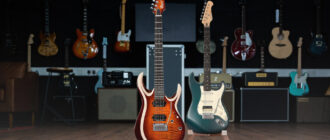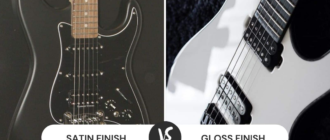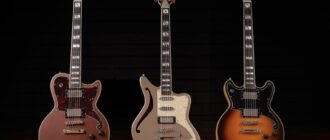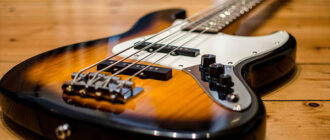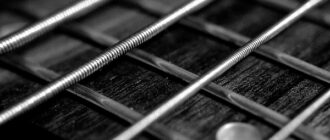The guitar neck profile is a fundamental component of the instrument. In a nutshell, the neck shape is the contour of the neck as seen from the rear of the fretboard.
This refers to the portion of the fretboard that extends from the nut to the beginning of the heel transition. The neck thickness of a guitar will not have a significant impact on the sound of the instrument, but it will have an impact on how it feels easier to play.
Different guitarists and bassists have radically different tastes about the types of thin necks available to them.
This is often affected by factors such as the size of the hands, the typical positioning of the hands (particularly the position of the thumb), and, of course, the thin neck shapes of the instruments that we have been used to playing or have learned easier to play.

Information for beginners
In most cases, manufacturers will provide us with the guitar’s thin neck shape to choose from in their guitar necks. So that we may select one that best suits our preferences and provides the most comfort, taking into account the size of our hands.
The difficulty arises, for instance, when we try out a guitar in a shop because the little amount of time we spend with it might skew our perception of the emotion it gives us.
Let’s make an effort to explain this in as few words as possible: a guitar with a narrow neck profile, also known as thinner neck guitar easier to play. It will initially provide us with a high level of comfort since it will be much simpler for us to access all the frets.
Doesn’t it make you feel at ease?
This first easiness will most likely need us to stretch our joints and fingers farther than is really easier to play. After we’ve been at it for a long, we’ll start to feel awkward and, what’s much worse, aggravated and painful in our muscles.
The second possible scenario is one in which the thicker neck and the hand can adjust very effectively to the breadth and curve of the instrument.
How very convenient! Again. When we have played for a considerable amount of time, we will determine whether it is difficult for us to accomplish tasks that involve more exertion and stretching of our fingers.
Tendinitis is a common condition that affects guitar amateurs, and it is often caused by circumstances similar to those that I have discussed here. Tendinitis may develop as a result of excessive efforts, stretching that is pushed by a slim taper, or failure to adjust to an appropriate profile.
In the slim taper, the thing that we need to take into consideration is that if it is difficult to perform in the upper portion of the guitar neck because of pain, then this calls for thinner neck guitars easier.
On the other hand, we need to take into consideration the fact that a thinner neck at the guitar neck section will need us to articulate the fingers more than we would normally.

Bottom line up front
The many forms of the guitar neck (variety of neck thickness) that we shall discuss in this piece may be broken down into two primary categories:
C, U, D, and V-shaped profiles are examples of symmetrical profiles (also soft V or hard V).
Asymmetrical profiles are a trend that allows for more customization and is created for some guitarists who prefer to reach the treble side of the guitar neck for soloing but also want to be able to comfortably and easier to play barre chords at the upper section of the fat neck.
What kind of profile does the guitar’s neck have?
The curved form that would result if one were to cut the guitar neck in the direction of the frets and at an angle that was perpendicular to the truss rod is what is meant by the word “profile.”
The phrase “guitar neck shapes” refers to the precise cross-sections of the top (in the region known as the nut) and bottom (in the area known as the heel), and back of the neck (above the 17th fret).
Changes in the two cross-sections’ form and size may lend the back of the neck and guitar a distinctive personality, feel, and degree of difficulty in playing, depending on the specifics of the design.
For the objectives of design and construction, these cross-sections are absolutely necessary. They are straightforward representations in two dimensions of a form that would be difficult to see in any other context. When seen throughout the whole length, these distinctions are very minor and almost hard to detect.
Thin necks
However, they are discernible when actually playing with thinner necks. A thinner neck may make profile templates by using these two cross-sections as their starting point (pieces of wood or other material to place on the neck as it is shaped).
Due to the increased density of the guitar neck thickness, instruments with wider or thicker neck thickness produce a sound that is more full-bodied and has a longer sustain. However, players with little hands may find it challenging to comfortably spread them with big neck thicknesses.
On the other hand, guitarists who play the slim taper and have big hands may find that a thinner neck guitar rather than a small one is more comfortable. When setting up chords, thin guitar necks like this one may also be easier on the hand since it is more pleasant to grasp.

Neck shapes in the forms of a C, V, D, and a U
The most typical shape for the thin guitar necks of an electric or acoustic guitar is either a half circle or a half oval. A “C profile” describes this particular outline.
And once you have that information, you can start to piece together how the V, D, and U profiles came into being.
Depending on the thickness of the guitar neck, as well as other characteristics such as slim taper, symmetry, and fretboard profile, these profiles, and really the vast majority of profiles, are capable of an almost limitless number of modifications.
Some musicians have a strong preference for high-profile instruments that have thick necks that are not perfectly symmetrical. Some manufacturers have distinctive characteristics that put them in a league of their own compared to other manufacturers.

C Neck
The C profile is regarded as one of the most well-liked variations of the thicker neck profile. The breadth of the profile is relatively comparable to that of the D shape.
However, the oval profile has a more rounded and consistent curve between the two sides of the fingerboard. It is also known as the Oval profile.
In general, this design is fairly comfy, flexible, and adaptable, and it works well with any style. The Fender Stratocaster models from the early 1960s all had a profile that looked like this one.
Examples in the form of a C:
- Fender American Standard Series
- Stratocaster from Fender, American Standard Model | Reverb
- Stratocaster from Fender, American Standard Model | Reverb
The American Standard Stratocaster is still an excellent choice for players looking for a go-to guitar that is also a best-seller, but it now has aged plastic components and a fuller tone than previous models.
U neck
The U-profile is pretty similar to the overall form of a C-profile; the main difference is that it is substantially deeper. In contrast to C-profiles, which begin to bend very immediately after the fingerboard, it has vertical sides that become more vertical as they descend.
They also often have vertical shoulders that are easy to see. A great number of thick necks that have a U-profile will be referred to as being heavy, obese, or some other derogatory adjective.
This particular thicker neck is known as a “U-shaped neck,” and it was characteristic of the original Fender Telecaster models that were produced in the 1950s. Alternately referred to as the “baseball bat” thinner neck guitars.
A bulky profile that is reminiscent of the form of the letter U, with rounded corners and a center back that is almost flat. Owning a form that is very comparable to the neck profile of a classical guitar. In modern electric guitars, you will not often come across a profile like this one.
Examples in the form of a U:
- Gibson ES-355
- Les Paul Gibson Standards from the ’50s
- Gibson Les Paul Standard ’50s Electric Guitar | Guitar Center
- Gibson Les Paul Standard ’50s Electric Guitar | Guitar Center
This Les Paul Standard ’50s exudes authenticity and serves as a reminder of Gibson’s long and illustrious history as a company that has been at the forefront of musical innovation.
The exquisite nitro-lacquer finish adds to the iconic appearance of the instrument’s classic figured maple on mahogany construction, as well as its 1950s-style neck shape.

V-neck guitar neck form
The profile is unique in that it is in the form of a V. This profile is comparable to the thick U-profile, but the edges have been reduced further, giving it the appearance of a soft V.
The flat portions seem to restrict hand rotation. In addition, a large number of guitarists have discovered that the form restricts the range of motion they are capable of.
On the other hand, this is the sole route open to a certain kind of guitarist.
The V-shape is preferred by blues guitarists like Eric Clapton, as well as guitarists who position their thumbs over the top of the fretboard since this allows them more access to higher frets.
It would seem that the V-shape is responsible for the vivid sound, although there is no research on the topic that has been peer-reviewed.
We have what is known as the hard or marked V-profile inside the V-profiles (Hard V). Due to the extreme specificity of this sort of profile, it is strongly recommended that you first get some experience with it before making a purchase.
There is also a form of neck profile known as a mixed or composite neck profile, which has one type of profile in the higher portion of the neck profile and another type of profile in the lower portion of the neck.
Examples in the form of a V:
- Eric Clapton Replica Stratocasters
- American Deluxe “V” Stratocasters
- Classic Stratocasters from the 50s
D neck
The typical C neck is the thinnest neck than the D profile, but the D profile is always flatter at the bottom (which makes it thinner to hold).
This particular design is often seen in instruments with thin guitar necks; for instance, classical and flamenco guitars frequently have a D neck.
Additionally, this is a smart move for guitar necks that have more than seven strings.
Examples in the form of a D:
- Ibanez JP20’s’
- Ibanez GB10
It is a stunning guitar that produces a lovely tone, and it has a spruce top, maple back and sides, and the George Benson neck design.
It’s George Benson Special pickups that are tailor-made for hollow-body guitars that are played at loud volumes.

The benefits and drawbacks of different thick neck shapes
The good and the bad of having a thin neck shape
As our recommendation, we advise you to try both of the shapes and consider your personal preference as the main point.
Asymmetric
Symmetry may be seen in the C, D, U, and V neck shapes. Beginning in the 1970s and continuing ahead, we began to see designs with asymmetrical neck profiles.
The thickness of the bass side is greater than that of the treble side, which has a somewhat smaller nut width. By designing the neck in this manner, we are able to create an instrument with a treble-plucking fingerboard that is not only easy to play but also pleasant to change chords on.
In most cases, illustrative examples of asymmetrical guitar neck shapes depict somewhat dramatic morphological changes. However, in the actual world, it is most usually seen as a somewhat minor impact (as the thinnest neck).
For instance, Gibson and PRS each have their own asymmetrical profiles, although they are on the more subtle side. Steve Ray Vaughan, a prominent figure in the Fender community, plays with a slightly asymmetrical C-neck.
If you wish to test out a profile of this sort, my recommendation is that you give the task of cutting it out to a professional luthier rather than doing it yourself.
Luthiers personalize these types of profiles.
This kind of guitar, which has thick guitar necks and results in instruments that are one of a kind, is popular among guitarists. Eddie Van Halen is likely going to be the most well-known name on this list.
Examples of an asymmetric neck shape include:
- EVH Wolfgang Standard.
- 2018 Gibson Les Paul HP
- Telecaster with the Brad Paisley Signature (country rock).
The D and the C are the two profiles that are used the most in modern times. Therefore, it is quite likely that you will not run into any issues while using profiles of this kind.
Wider profiles are an option, nevertheless, for the few who could have difficulties using these particular ones.

FAQ
Are thicker necks better?
There is no one correct answer; nevertheless, the thin guitar neck in the form of a C, which can be seen on many guitars that are similar to those made by Fender and are widely regarded to be the simplest to play, is the most prevalent.
Which neck shape is best?
The answer is thinner, and this is something that is especially true for people who have little hands. Additionally, fretboards with a neck radius of 12 inches or more are simpler to play than those with a flatter profile. One example of this would be the D’Angelico Premier Atlantic.
Which model of the fender guitar has the neck that is the thinnest?
It is supposed to be the American Professional Cobain Jaguar that belonged to Kurt Cobain at this point. The proportions of the neck of the Fender Mustang are comparable.
What exactly is meant by the term “Clapton neck”?
It got its name from the delicate V-neck guitar neck that Eric Clapton popularized. He feels the most at ease with a 1950s V profile that is not quite as prominent as others of its kind.
What kind of thickness does the Stratocaster neck have?
In most cases, the neck is in the form of a C and is between 21 and 23 millimeters when measured from side to side. They have a well-deserved reputation for being “easier” guitars to solo on than, for example, guitars from the Epiphone Jazz line.
What are the advantages of thick neck?
Players who play rhythm guitar may choose thick guitar necks that are thicker than average because they provide more hand support, which is beneficial while chording. When attempting to play barre chords, very thin necks may feel awkward and cause hand cramping in certain players. This is especially true for those who play electric guitar.
Are thicker guitar necks more stable?
It’s possible that a thin guitar neck with a bigger nut might be more sturdy, but that’s not a guarantee. There are thin necks available that are crafted from laminated, sturdy, well-dried woods. These thick guitar necks are further strengthened with an effective truss rod and carbon fiber rods. These may be quite reliable over long periods of time.
Conclusion
After all, when we grow accustomed to the neck thickness, and we play for hours and hours silently and pleasantly, it is possible that when we change, we may have aches and pains.
Because of this, several well-known guitar players, such as Mike Eizinger from the band Incubus, have been forced to switch to guitars that have necks that are specifically designed for them.

